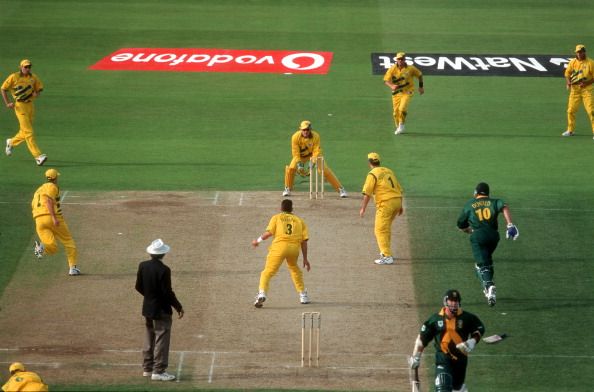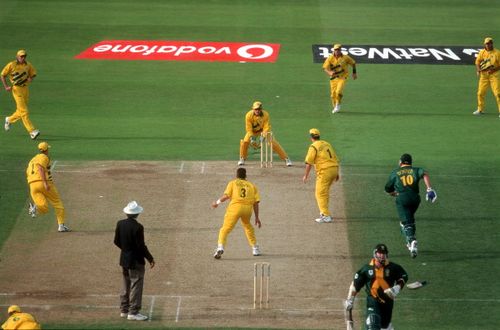
Have 300+ run-chases taken the charm away from the ODI game?

Sample 2 matches:
Match 1 – Team A scores 383 with an opener scoring a double hundred and 19 sixes are hit in this innings. Team B scores 326 all out in the chase in just 45 overs and 19 sixes in this innings too. Over 700 runs scored in 95 overs.
Match 2 – Team A scores 247 in 50 overs on a tough pitch with their captain scoring 92 and then going on to defend the total successfully by bowling Team B out for 225 in 44 overs, picking up the last 4 wickets for under 40 runs. Just 8 sixes hit in the entire match.
Which match do you think would have been more exciting or “nail-biting” to watch? Clearly, match 2.
Why? Let’s see.
When a team batting first scores in excess of 300, more often than not the fate of the match is sealed. Chasing a total of over 300 successfully is not something that happens very often even today. In fact, till the 70s-80s and even in the 90s, a total of over 300 mostly meant that the team batting second had almost no chance at all and at times teams didn’t even try chasing it down.
Also read: The definition of short-pitched bowling could undergo a change
Moreover, a score of over 300 means that poor bowlers had a terrible day at the office, majorly because of the pitch provided to them for the match to bowl on. Batsmen can hit through the line and on the up, and the ball comes nicely on to the bat. Add to that the sizes of the bats these days, and the bowlers have nowhere to hide. All the batsmen need to do is turn up for the game and runs are on offer, whereas the bowlers, despite tireless efforts, return figures that are nothing to write home about.
A team scoring in excess of 300 was a rarity till the 90s, but in the last few years, and especially with the advent of T20 cricket, such scores have been racked up by teams with alarming frequency.
Let’s see the total no. of times Test playing nations have scored more than 300 in an ODI innings till date:
| Team | Matches | Won | Lost | Tied | No Result | Win/Loss Ratio |
| Australia | 91 | 80 | 10 | 0 | 1 | 8.00 |
| India | 90 | 71 | 17 | 2 | 0 | 4.18 |
| South Africa | 73 | 66 | 6 | 0 | 1 | 11.00 |
| Pakistan | 66 | 58 | 8 | 0 | 0 | 7.25 |
| Sri Lanka | 59 | 48 | 11 | 0 | 0 | 4.36 |
| New Zealand | 49 | 38 | 9 | 2 | 0 | 4.22 |
| England | 48 | 31 | 15 | 2 | 0 | 2.07 |
| West Indies | 35 | 26 | 9 | 0 | 0 | 2.89 |
| Zimbabwe | 23 | 18 | 5 | 0 | 0 | 3.60 |
| Bangladesh | 9 | 8 | 1 | 0 | 0 | 8.00 |
The win/loss ratio, especially for the top 4 teams in this table clearly illustrates the point raised earlier in the article, on how a match is virtually decided once a team batting first goes past 300.
Talking about the times teams have had to chase over 300 and managed to cross 300 themselves during it, the stats are given below:
| Team | Matches | Won | Lost | Tied | No Result | Win/Loss Ratio |
| India | 24 | 16 | 7 | 1 | 0 | 2.29 |
| Australia | 10 | 9 | 1 | 0 | 0 | 9.00 |
| Sri Lanka | 14 | 8 | 6 | 0 | 0 | 1.33 |
| Pakistan | 11 | 7 | 4 | 0 | 0 | 1.75 |
| South Africa | 9 | 7 | 2 | 0 | 0 | 3.50 |
| England | 9 | 5 | 3 | 1 | 0 | 1.66 |
| New Zealand | 9 | 4 | 4 | 1 | 0 | 1.00 |
| Bangladesh | 3 | 3 | 0 | 0 | 0 | -- |
| Zimbabwe | 5 | 2 | 3 | 0 | 0 | 0.66 |
| West Indies | 3 | 1 | 2 | 0 | 0 | 0.50 |
Having a look at the same stats for the last 5 years tells us how the frequency of such scores has gone up alarmingly
| Team | Matches | Won | Lost | Tied | No Result | Win/Loss Ratio |
| South Africa | 30 | 27 | 2 | 0 | 1 | 13.50 |
| Australia | 30 | 24 | 6 | 0 | 0 | 4.00 |
| India | 30 | 22 | 6 | 2 | 0 | 3.66 |
| Sri Lanka | 24 | 18 | 6 | 0 | 0 | 3.00 |
| New Zealand | 20 | 15 | 4 | 1 | 0 | 3.75 |
| England | 24 | 14 | 9 | 1 | 0 | 1.55 |
| Pakistan | 14 | 12 | 2 | 0 | 0 | 6.00 |
| West Indies | 9 | 8 | 1 | 0 | 0 | 8.00 |
| Bangladesh | 5 | 4 | 1 | 0 | 0 | 4.00 |
| Zimbabwe | 5 | 3 | 2 | 0 | 0 | 1.50 |
India and Australia have scored a third of their total 300+ scores in the last 5 years. South Africa have scored over 40% of their total such scores in the same period.
Looking at teams scoring 300+ while chasing a target in the last 5 years
| Team | Matches | Won | Lost | Tied | No Result | Win/Loss Ratio |
| Australia | 7 | 6 | 1 | 0 | 0 | 6.00 |
| India | 9 | 6 | 2 | 1 | 0 | 3.00 |
| South Africa | 5 | 4 | 1 | 0 | 0 | 4.00 |
| England | 5 | 3 | 1 | 1 | 0 | 3.00 |
| Sri Lanka | 6 | 3 | 3 | 0 | 0 | 1.00 |
| Bangladesh | 2 | 2 | 0 | 0 | 0 | -- |
| Pakistan | 3 | 2 | 1 | 0 | 0 | 2.00 |
| Zimbabwe | 4 | 2 | 2 | 0 | 0 | 1.00 |
| New Zealand | 1 | 1 | 0 | 0 | 0 | -- |
The above table tells us how in the last 5 years when teams have scored more than 300 in the second innings of the match, they have ended up on the winning side very often. This means that in the match, the only thing that happened was batsmen making merry, or in other terms, no balance between bat and ball. Bowlers from both teams were plundered mercilessly, and throughout the 100 overs, there was no respite for them.
The question is – Does it keep the viewer intrigued in the match if all that is seen from over 1 through 100 is just fours and sixes and no great bowling spells? I’d think not.
Some of the greatest matches in the history of one-day cricket have been low scoring thrillers. Perhaps the greatest ODI of all time in the opinion of most cricket fans, as well as experts, was the semi-final of the 1999 World Cup between Australia and South Africa. The match ended in a tie with both teams scoring 213 runs, and no one could tell till that tragi-comic run-out in the last over who was going to win a place in the World Cup final!
India beat South Africa in an ODI by 1 run, just before the start of the 2011 World Cup. Scoring just 190 batting first, they bowled South Africa out for 189 when at one stage, they needed less than 40 to win with 6 wickets in hand. Imagine how thrilling that phase would have been when India picked up all 6 wickets with just the solitary run to spare? There are numerous such examples.
Also read: Salman Khan's sister to produce the film on India's 1983 World Cup triumph
Teams scoring over 300 batting first as well as second does indeed take a lot of the charm away from one-day games as the proceedings then become too predictable and monotonous. A fan always wants to see a match in which there is a balance between bat and ball and a player needs to show technique, talent as well as grit and determination to earn a win for his side.

Such matches happen when we have pitches that offer at least some help to the bowlers, and when this happens, the scores are generally not over 300.
But it is these matches which give a real sense of thrill and excitement to a viewer watching in the stadium as well as on TV, as the tension mounts every ball. Every boundary matters, so does each wicket. There is nothing like watching a team successfully defend a score which looked well below par at the end of the first innings.
Cricket administrators would do well to provide such pitches for ODIs as well as some tweaks to the rules that ensure lesser mountainous scores and a more even contest between bat and ball, so as to break the monotony of fours and sixes in a match and maintain the fan’s interest and nervous tension.
We can only hope it starts happening sooner rather than later!